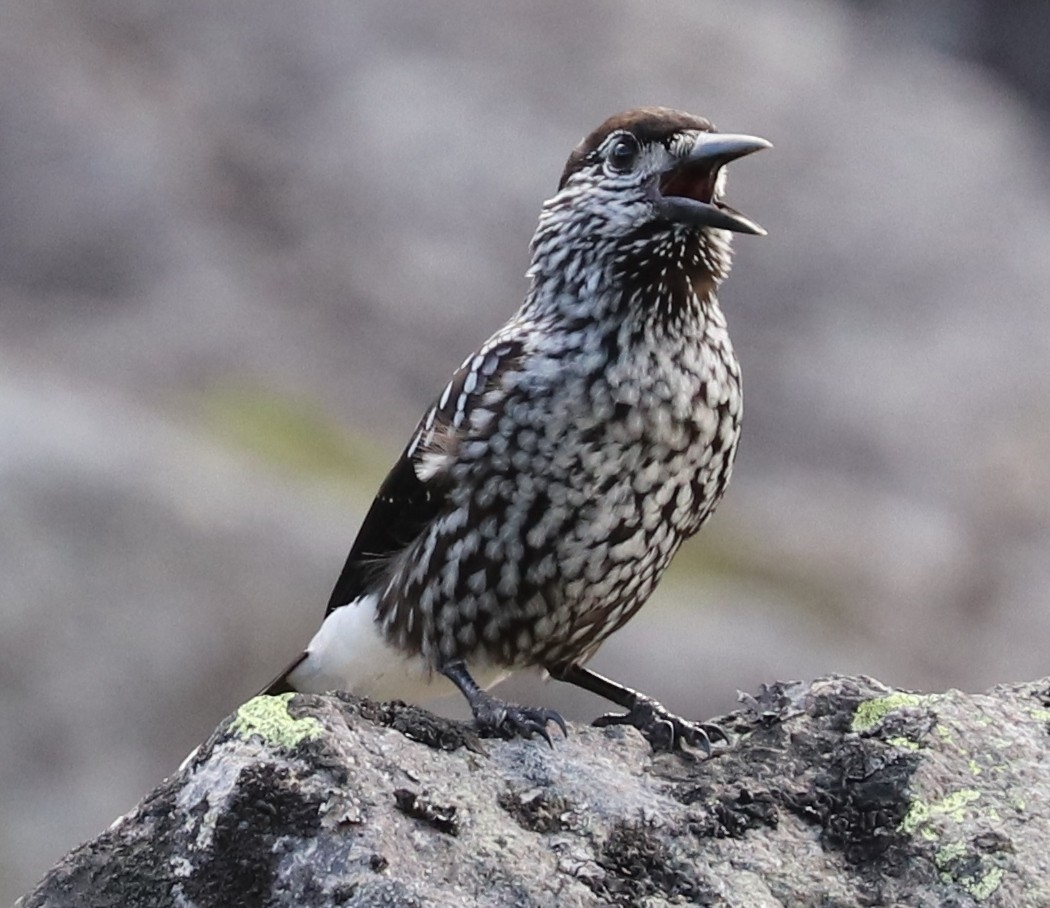Spotted Nutcracker
A species of Nutcrackers Scientific name : Nucifraga caryocatactes Genus : Nutcrackers
Spotted Nutcracker, A species of Nutcrackers
Botanical name: Nucifraga caryocatactes
Genus: Nutcrackers
Content
Description People often ask General Info
 Photo By Alpsdake , used under CC-BY-SA-4.0 /Cropped and compressed from original
Photo By Alpsdake , used under CC-BY-SA-4.0 /Cropped and compressed from original Description
The spotted nutcracker is a dark brown, broad-winged, short-tailed corvid. Body plumage is mid-to-dark chocolate brown, heavily spotted with white on face, neck, mantle and underparts. It has a large white loral spot, a white eye-ring, blackish-brown cap extending onto the nape, dark blackish wings with a greenish-blue gloss, all white vent, and dark tail with white corners above and a white terminal band on the undertail. In flight, broad wings, white vent and short tail are noticeable; the flight undulating. The black bill is slender and rather long, sharply pointed, and varies in size amongst races. The iris, legs and feet are black. Nutcrackers range from 32–38 cm in length (from tip of beak to tip of tail) and have a wingspan ranging from 49–53 cm. The voice is similar to that of the Eurasian jay and is loud and harsh. It is described as kraak-kraak-kraak-kraak. 
Size
34 cm
Colors
Brown
Black
White
Variegated
Life Expectancy
8 years
Nest Placement
Tree
Feeding Habits
Spotted Nutcracker predominantly feeds on large-seeded pine nuts, supplementing with spruce seeds, hazelnuts, insects, small birds, eggs, nestlings, and carrion. They exhibit unique bill adaptations for nut-cracking and a specialized tongue for seed-handling. Spotted Nutcracker stores excess seeds, inadvertently sowing new pine forests.
Habitat
Spotted Nutcracker predominantly thrive in coniferous and mixed forests of vast taiga and mountainous regions. Their range includes areas rich in Norway spruce, Swiss pine, and other conifer varieties, extending to Eurasian terrains composed of European silver fir and Siberian pine. Adaptable to various conditions, spotted Nutcracker also inhabit mixed Himalayan forests at altitudes up to 4000 meters, spanning conifers and broadleaf species like rhododendron.
Dite type
Granivorous
People often ask
General Info
Feeding Habits
Bird food type
Distribution Area
The spotted nutcracker has an extensive range forming a broad swathe east–west from Scandinavia right across northern Europe, Siberia and to eastern Asia, including Japan, inhabiting the huge taiga conifer forests in the north. Three further disjunct populations occur in mountain conifer forests further south, one centered on the mountains of central and southeast Europe (the Alps, the Carpathians and the Balkan Peninsula mountains); another in the western Himalayas; and the third in western China seaboard and separated from the northern population by a relatively small gap in the north centre of China. See subspecies list above for race distributions. Some of the populations can be separated on bill size. This species has a large range, extending over 10,000,000 km globally. It also has a large global population, with an estimate of between 800,000-1,700,000 individuals in Europe. Spotted nutcrackers are not migratory, but will erupt out of range when a cone crop failure leaves them short of a food supply, the thin-billed eastern race macrorhynchos being the more likely to do this. Britain records very sporadic vagrants, but in 1968 over 300 nutcrackers visited Britain as part of a larger irruption into western Europe, probably due to a spell of early cold weather in Siberia. 
Species Status
Not globally threatened.
Scientific Classification
Phylum
Chordates Class
Birds Order
Perching birds Family
Crows and jays Genus
Nutcrackers Species
Spotted Nutcracker